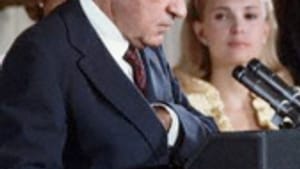Stay in the Loop
BSR publishes on a weekly schedule, with an email newsletter every Wednesday and Thursday morning. There’s no paywall, and subscribing is always free.
Sarah Palin as the new Nixon

Found: Sarah Palin's role model
STEVE COHEN
Sarah Palin's vice presidential candidacy reminds me so much of Richard Nixon's in 1952.
Certainly no other Vice Presidential candidate's speech has been as apprehensively and gleefully anticipated as was Nixon's on the night of September 23, 1952.
Although we were too young to vote, my school friends and I followed that election campaign. We looked forward to seeing how Tricky Dick would try to squirm out of the revelation that conservative businessmen had set up a slush fund for Nixon's personal use. My friends thought Nixon wouldn’t be able to clear himself and that Eisenhower would drop him and choose someone else as his Republican running mate.
None of my friends supported Eisenhower, although we admired him as a war hero. (Sound familiar?) We were enamored of Adlai Stevenson, the Illinois egghead who sounded so smart in his speeches and on the talk shows. (Again, familiar?)
We scorned Nixon because he had a reputation as an opportunistic Commie-hunter. We suspected that he'd burn books if he was given the chance— something Sarah Palin actually suggested as mayor of Wasilla before she backed away from it.
The ‘Checkers’ speech
Nixon, like Palin 56 years later, used his airtime to attack his opponents and to recount his life story in maudlin fashion. He identified himself as one of "the common people." He was so poor, he said, that he couldn't buy his wife a mink coat. All he could afford was a "respectable Republican cloth coat," but he told Pat, "She'd look good in anything." This line of reasoning was supposed to prove that he had not enriched himself with bribes.
Nixon acknowledged receiving one personal gift: a black-and-white cocker spaniel that his daughters named Checkers— and, "regardless of what they say," he wasn’t going to take that dog away from the girls. Pat was there in the studio, on camera. We who watched this exhibition all felt that this focus on Nixon’s family was shamelessly exploitive, not to mention irrelevant to the real issues he managed to avoid discussing.
"Yuck," was the reaction among my smart friends. "We like him," was the verdict of most Americans. Their reasons for approval were similar to Palin's today: Nixon seemed like a regular guy, he was a man with family values, and he was feisty.
About that skirt and heels…
Some Democrats were smiling the morning after Nixon's speech because they felt he revealed himself to be so smarmy that Americans surely would reject him. Similarly, some Democrats today think that the nation will reject Palin and McCain because of her lack of depth or her extremism. Don't count on that.
There are differences, to be sure. Nixon's persona, at least in his speech, was modest, whereas Palin's was flippant. Nixon, unlike Palin, was a very intelligent man with a knowledge of foreign affairs (even if he tried to hide it). On the other hand, Palin is much more attractive than Nixon. It’s no accident that she always wears a skirt and high heels in public. Some Republicans say she "looks hot." She could be more electorally dangerous than Nixon.
Palin mimics Nixon by tapping in to the anti-Establishment, anti-intellectual bias that presently pervades the nation. We need to remember that this approach worked: Nixon was elected vice president twice and president twice more. McCain may not have put his country first when he picked Palin as his running mate. But from a politically strategic point of view, he may indeed have chosen the most effective running mate.
To read responses, click here and here.
STEVE COHEN
Sarah Palin's vice presidential candidacy reminds me so much of Richard Nixon's in 1952.
Certainly no other Vice Presidential candidate's speech has been as apprehensively and gleefully anticipated as was Nixon's on the night of September 23, 1952.
Although we were too young to vote, my school friends and I followed that election campaign. We looked forward to seeing how Tricky Dick would try to squirm out of the revelation that conservative businessmen had set up a slush fund for Nixon's personal use. My friends thought Nixon wouldn’t be able to clear himself and that Eisenhower would drop him and choose someone else as his Republican running mate.
None of my friends supported Eisenhower, although we admired him as a war hero. (Sound familiar?) We were enamored of Adlai Stevenson, the Illinois egghead who sounded so smart in his speeches and on the talk shows. (Again, familiar?)
We scorned Nixon because he had a reputation as an opportunistic Commie-hunter. We suspected that he'd burn books if he was given the chance— something Sarah Palin actually suggested as mayor of Wasilla before she backed away from it.
The ‘Checkers’ speech
Nixon, like Palin 56 years later, used his airtime to attack his opponents and to recount his life story in maudlin fashion. He identified himself as one of "the common people." He was so poor, he said, that he couldn't buy his wife a mink coat. All he could afford was a "respectable Republican cloth coat," but he told Pat, "She'd look good in anything." This line of reasoning was supposed to prove that he had not enriched himself with bribes.
Nixon acknowledged receiving one personal gift: a black-and-white cocker spaniel that his daughters named Checkers— and, "regardless of what they say," he wasn’t going to take that dog away from the girls. Pat was there in the studio, on camera. We who watched this exhibition all felt that this focus on Nixon’s family was shamelessly exploitive, not to mention irrelevant to the real issues he managed to avoid discussing.
"Yuck," was the reaction among my smart friends. "We like him," was the verdict of most Americans. Their reasons for approval were similar to Palin's today: Nixon seemed like a regular guy, he was a man with family values, and he was feisty.
About that skirt and heels…
Some Democrats were smiling the morning after Nixon's speech because they felt he revealed himself to be so smarmy that Americans surely would reject him. Similarly, some Democrats today think that the nation will reject Palin and McCain because of her lack of depth or her extremism. Don't count on that.
There are differences, to be sure. Nixon's persona, at least in his speech, was modest, whereas Palin's was flippant. Nixon, unlike Palin, was a very intelligent man with a knowledge of foreign affairs (even if he tried to hide it). On the other hand, Palin is much more attractive than Nixon. It’s no accident that she always wears a skirt and high heels in public. Some Republicans say she "looks hot." She could be more electorally dangerous than Nixon.
Palin mimics Nixon by tapping in to the anti-Establishment, anti-intellectual bias that presently pervades the nation. We need to remember that this approach worked: Nixon was elected vice president twice and president twice more. McCain may not have put his country first when he picked Palin as his running mate. But from a politically strategic point of view, he may indeed have chosen the most effective running mate.
To read responses, click here and here.
Sign up for our newsletter
All of the week's new articles, all in one place. Sign up for the free weekly BSR newsletters, and don't miss a conversation.

 Steve Cohen
Steve Cohen